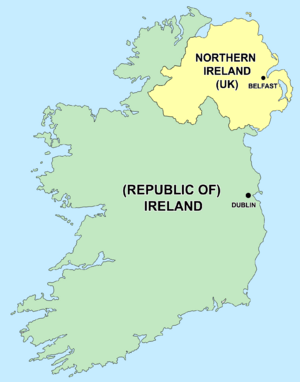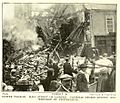Partition of Ireland facts for kids
The partition of Ireland was when the United Kingdom government split Ireland into two self-governing parts. These parts were Northern Ireland and Southern Ireland. This happened on 3 May 1921, under a law called the Government of Ireland Act 1920.
The plan was for both parts to stay in the United Kingdom. It also hoped they would eventually reunite. The smaller Northern Ireland was created with its own local government. It stayed part of the UK.
Most people in the larger Southern Ireland did not accept this. Instead, they supported the independent Irish Republic. On 6 December 1922, Southern Ireland left the UK. It became the Irish Free State, which is now the Republic of Ireland.
The area that became Northern Ireland is in the Irish province of Ulster. Most people there were Protestant and Unionist. They wanted to stay connected to Britain. This was partly because of British settlement in the 1600s. However, Northern Ireland also had many Catholics and Irish nationalists. These groups wanted to be part of an independent Ireland.
The rest of Ireland had a Catholic, nationalist majority. They wanted their own government or full independence.
Contents
Why Ireland Was Divided
Early Ideas for Home Rule
For many years, Irish people wanted "Home Rule." This meant having their own government within the UK. The British government tried to pass laws to allow this. But this led to big problems between 1912 and 1914.
Unionists in Ulster strongly opposed Home Rule. They formed a group called the Ulster Volunteers. This group was ready to fight to stop Ulster from being ruled by an Irish government. The British government thought about keeping all or part of Ulster separate. But then World War I started in 1914, and these plans were put on hold.
War and Independence
During World War I, more and more Irish people wanted full independence. In the 1918 election, the Irish republican party Sinn Féin won most of the seats in Ireland. They set up their own Irish parliament. They declared an independent Irish Republic for the whole island.
This led to the Irish War of Independence (1919–1921). It was a guerrilla war between the Irish Republican Army (IRA) and British forces.
In 1920, the British government passed a new law. This law created two local governments: one for six northern counties (Northern Ireland) and one for the rest of the island (Southern Ireland). This was the Government of Ireland Act. It became law on 3 May 1921.
After elections in 1921, Ulster unionists formed a government for Northern Ireland. But in Southern Ireland, republicans did not form a government. They only recognized the Irish Republic.
Violence and the Treaty
Between 1920 and 1922, there was much violence in what became Northern Ireland. People fought for or against the new division. In Belfast, the capital, there was "savage" violence between Protestants and Catholics. More than 500 people were killed. Over 10,000 became refugees, mostly Catholics.
The War of Independence ended with a truce in July 1921. This led to the Anglo-Irish Treaty in December. Under this treaty, Southern Ireland would leave the UK and become the Irish Free State. Northern Ireland's parliament could choose to join or leave the Free State. A special commission would then decide the exact border.
In early 1922, the IRA tried to attack border areas of Northern Ireland but failed. The Northern Ireland government chose to stay in the UK. In 1925, the Boundary Commission suggested small changes to the border. But these changes were never made.
After the Division
Continuing Disagreements
Since the partition, Irish nationalists and republicans still want a united independent Ireland. But Ulster unionists and loyalists want Northern Ireland to stay in the UK.
The Unionist governments in Northern Ireland were accused of treating the Irish nationalist and Catholic minority unfairly. A group called the Northern Ireland Civil Rights Association campaigned to end this unfair treatment. Loyalists opposed this, saying it was a republican plan.
This led to the Troubles (around 1969–1998). This was a thirty-year conflict where over 3,500 people were killed.
The Good Friday Agreement
In 1998, the Good Friday Agreement was signed. The Irish and British governments and the main political parties agreed on it. They decided that Northern Ireland's status will only change if most of its people agree.
Irish Constitution of 1937
In 1937, a new Constitution of Ireland was approved in the Irish Free State. It said that the "national territory" included "the whole island of Ireland, its islands and the territorial seas." The state was named 'Ireland'.
To unionists in Northern Ireland, this constitution made them even less likely to want to unite with the South. Most unionists were Protestant. The constitution also mentioned the "special position" of the Roman Catholic Church. This worried many Protestants.
In 1998, as part of the Belfast Agreement, the parts of the constitution claiming all of Ireland were removed.
Anti-Partition Groups
Many nationalist groups were formed to campaign against the border. These groups wanted to end the partition. They included the Anti-Partition League. However, none of these groups ever won enough support to change the situation.
Sports and Transport
After partition, some sports and social groups divided. But others did not. Today, many sports in Ireland, like boxing, Gaelic football, hurling, and rugby union, are organized for the whole island. This means one team represents Ireland in international games.
Other sports, like soccer, have separate groups for Northern Ireland and the Republic of Ireland. At the Olympics, athletes from Northern Ireland can choose to represent either "Ireland" or "Great Britain."
Rail transport in Ireland was also greatly affected. Many railway lines that crossed the border were closed. Today, only the line from Dublin to Belfast remains. Some counties in Ireland no longer have any train services.
Images for kids
-
Catholic-owned businesses destroyed by loyalists in Lisburn, August 1920
See also
 In Spanish: Partición de Irlanda para niños
In Spanish: Partición de Irlanda para niños









